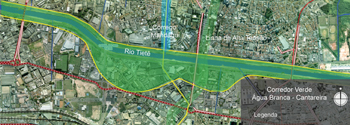CORRIDOR OF ÁGUA BRANCA PARK - CANTAREIRA: THE POTENTIAL OF LINEAR INFRASTRUCTURES FOR THE IMPLEMENTATION OF A SYSTEM OF GREEN AREAS
DOI:
https://doi.org/10.11606/issn.2179-2275.v0i12p70-95Keywords:
urban mobility, linear infrastructure, green corridors, ecological corridors, Água Branca Park, Serra da Cantareira State ParkAbstract
This article makes a reading on the development of green areas systems under the point of view of the public transport and linear infrastructure in the axis of the North-South Trail of São Paulo City, between Água Branca Park and Serra da Cantareira State Park. For this purpose, it was made a brief clarification of concepts and principles related to sustainable urban mobility and the ecological and landscape connections between green spaces. In what it is relevant to sustainable urban mobility theme, concepts of Jeffrey Tumlin, from the Institute for Transportation and Development Policy, and some studies focusing the use of green areas in linear infrastructure were mentioned. Then, in what it is relevant to the theme ecological and landscape connection among green spaces, renowned experts of these subjects were quoted, especially Jack Ahern and Richard Forman. Finally, based especially in the concepts of mentioned academic experts and the in environmental design theories discussed during the Laboratory “Environmental Design” of the Post Graduation program of FAU-USP in 2016, it has been proposed some design guidelines which enable a simple and effective connection of the Água Branca Park to the Serra da Cantareira Park.Downloads
References
AHERN, Jack. Greenways as a planning strategy. Elsevier: Landscape and urban planning, v.33, p131-155. 1995. Disponível em: <http://carmelacanzonieri.com/3740/readings/Greenways/greenways%20as%20planning%20strategy.pdf>. Acesso em: 06 maio 2016.
__________. Greenways as a planning strategy. In: FABOS, J.; AHERN, J.(ed.). Greenways: the beginning of na international movement, p.131-55. Amsterdam: Elsevier, 1996.
__________. Greenways in the USA: theory, trends and prospects. Amherst: University of Massachussets Press, 2003. Disponível em: < http://people.umass.edu/jfa/pdf/Greenways.pdf>. Acesso em: 07 maio 2016.
BONDAR, Camila S.; HANNES, Evy. Infraestrutura verde para o bairro do Mandaqui: possibilidade ou utopia? Revista Labverde: FAUUSP. São Paulo, n.9, p.30-52, dez. 2014.
CORAL, Elisa. Modelo de planejamento estratégico para a sustentabilidade empresarial. 2002. 282f. Tese (Doutorado em Engenharia da Produção). Universidade Federal de Santa Catarina, Florianópolis – SC, 2002.
DRAMSTAD, Wenche E.; OLSON, James D.; FORMAN, Richard T. T. Landscape Ecology Principles in Landscape Architecture and Land-Use Planning. Cambridge: Harvard University Graduate School of Design, Island Press and ASLA, 1996.
FERREIRA, José Carlos; MACHADO, João Reis. Infraestruturas verdes para um futuro urbano sustentável. O contributo da estrutura ecológica e dos corredores verdes. Revista Labverde: FAUUSP. São Paulo, n.1, p.69-90, out. 2010. Disponível em: <http://www.fau.usp.br/depprojeto/revistalabverde/edicoes/ed01.pdf>. Acesso em: 07 maio 2016.
FORMAN, Richard T. T. Land Mosaics: The Ecology of Landscapes and Regions. Cambridge: Cambridge University Press, 1995.
FORMAN, Richard T. T.; GODRON, Michel. Landscape Ecology. New York: John Wiley& Sons, Inc., 1986.
FRANCO, Maria de Assunção Ribeiro. Infraestrutura verde em São Paulo: O caso do corredor verde Ibirapuera - Villa Lobos. Revista Labverde: FAUUSP. São Paulo, n.1, p.134-154, out. 2010. Disponível em: <http://www.fau.usp.br/depprojeto/revistalabverde/edicoes/ed01.pdf>. Acesso em: Acesso em: 07 maio 2016.
FRISCHENBRUDER, Marisa T Mamede; PELLEGRINO, P. R. M. . Using greenways to reclaim nature in Brazilian cities. Landscape and Urban Planning, Holanda, v. 76, n.1-4, p. 67-78, 2006.
JORDÃO, Maria Aurélia da Silva Martins. Impacto da Urbanização nos Ecossistemas Representativos Locais de Áreas Verdes Essenciais para a Proteção dos Recursos Hídricos – Parque da Água Branca. São Paulo: Monografia (MBA em Gestão Ambiental e Especialização lato sensu) - PROENCO Brasil Ltda, 2007. 66p.
KIHSLINGER, Rebecca; WILKINSON, Jessica; MCELFISH, James. Corredores de biodiversidade. In: FARR, Douglas. Urbanismo sustentável: desenho urbano com a natureza. Porto Alegre: Bookman, 2013. Pags. 112-117.
INSTITUTO DE ENGENHARIA (São Paulo). Do outro lado do rio: as ideias do passado para recuperar o rio Tietê, em São Paulo. Disponível em: < http://www.institutodeengenharia.org.br/site/noticias/print/id_sessao/4/id_noticia/8009>. Acesso em: 15 maio 2016.
INSTITUTO DE POLÍTICAS DE TRANSPORTE E DESENVOLVIMENTO – IPTD. Desestímulo ao uso do Automóvel. Disponível em <http://itdpbrasil.org.br/o-que-fazemos/desestimulo-ao-automovel/> Acesso em: mai. 2016
LITTLE, Charles E. Greenways for America: Creating the North America landscape. Baltimore: Johns Hopkins. University Press, 1990.
MORON D, SKORKA P, LENDA M, ROZEJ-Pabijan E, WANTUCH M, KAJZER-BonkJ, et al. Railway embankments as new habitat for pollinators in na agricultural landscape. PLoS One. 2014; n. 9: e101297.
NAIMAN, Robert J.; DÉCAMPS, Henri; POLLOCK, Michael.
The Role of Riparian Corridors in Maintaining Regional Biodiversity. Ecological Aplications. Vol. 3, p. 209-212, 1993. Disponível em: <http://www.jstor.org/stable/1941822?seq=1#page_scan_tab_contents>. Acesso em: 05 maio 2016.
RODRIGES, Paulo Roberto Ambrosio. Introdução aos Sistemas de Transporte no Brasil. Brasil: ADUANEIRAS, 2007. 248p.
ROWE, Peter. Os resultados e a história do projeto de restauração do Cheonggyecheon, em Seul, que derrubou uma via expressa elevada e propôs um espaço de lazer em torno ao córrego. Revista AU: PINI. São Paulo, edição 234, out. 2013. Disponível em: <http://au.pini.com.br/arquitetura-urbanismo/234/restauracao-do-cheonggyecheon-seul-coreia-do-sul-296126-1.aspx> Acesso em: 15 maio 2016.
SEARNS, Robert M. The evolution of greenways as an adaptative urban landscape form. Elsevier: Landscape and urban planning, v.33, p65-80. 1995. Disponível em: < http://carmelacanzonieri.com/3740/readings/Greenways/evolution%20of%20greenways.pdf>. Acesso em: 07 maio 2016.
TUMLIN, Jeffrey. Sustainable Transportation Planning. WILEY, 2011. 320p

Downloads
Published
Issue
Section
License
O detentor dos direitos autorais é o autor e eventuais coautores do artigo. A Revista LABVERDE exige apenas o ineditismo na publicação do artigo. O autor tem o direito de divulgar seu artigo conforme sua conveniência devendo citar a revista.
A Revista LABVERDE autoriza a republicação de seus artigos desde que devidamente citada fonte e autoria.


